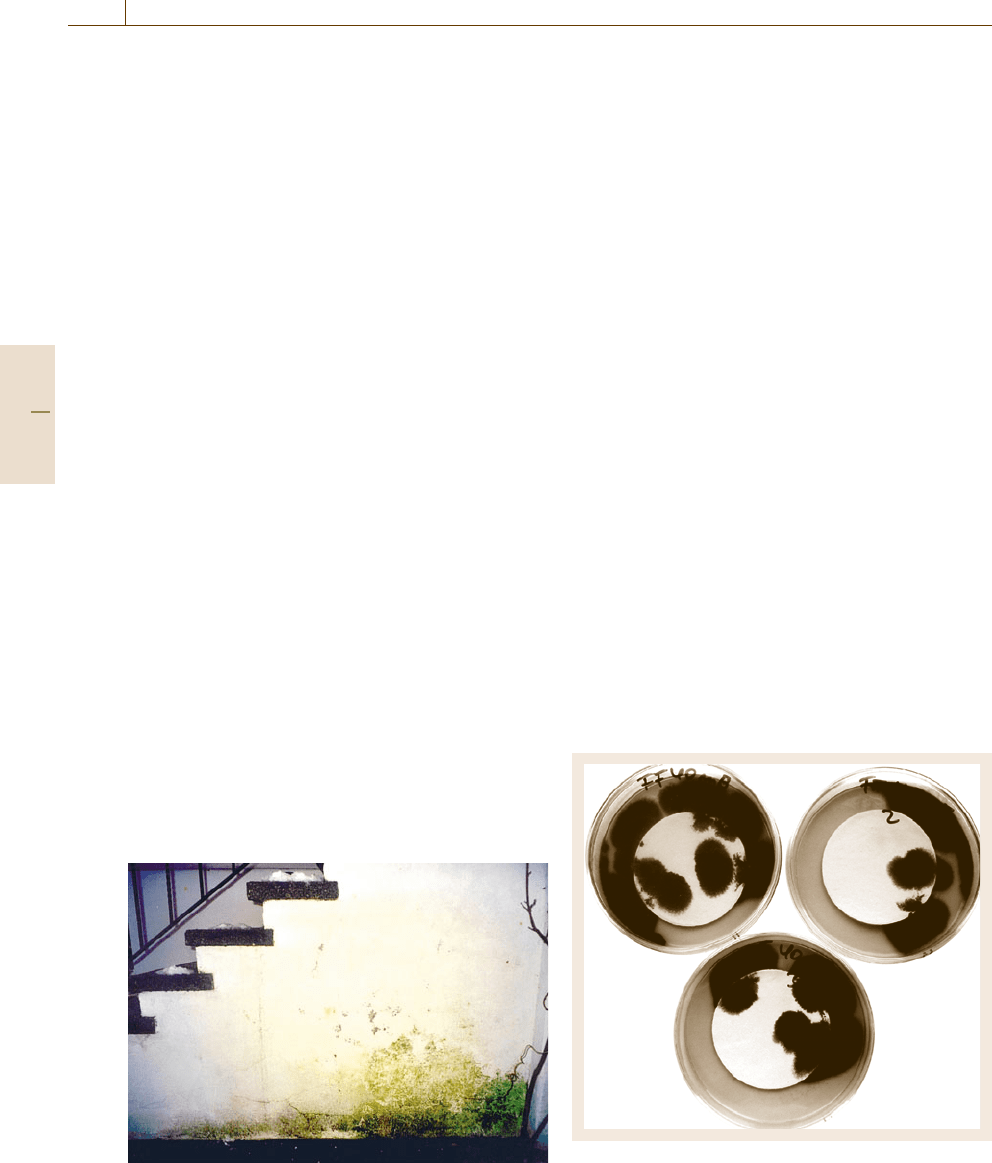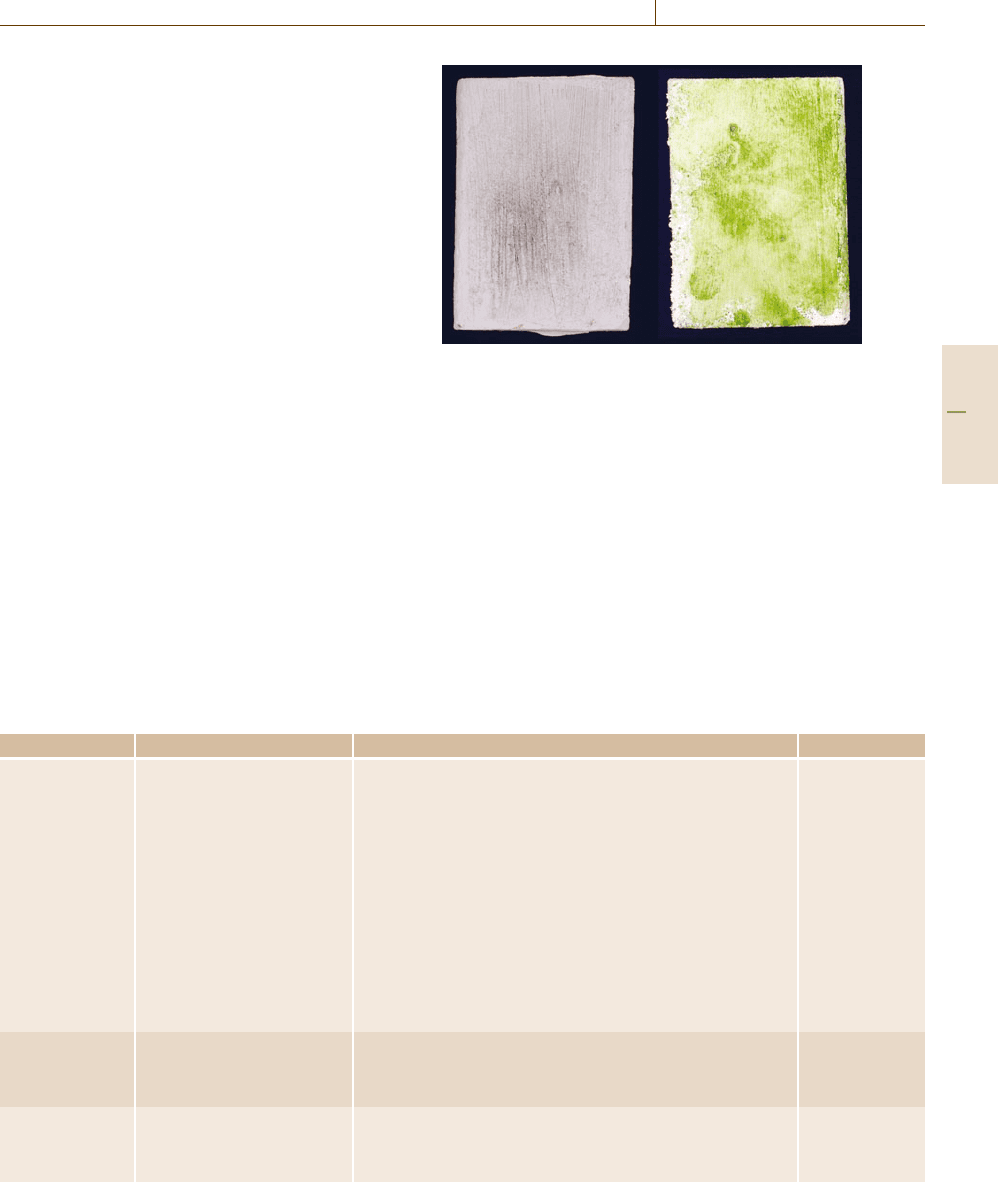Czichos H., Saito T., Smith L.E. (Eds.) Handbook of Metrology and Testing
Подождите немного. Документ загружается.


818 Part D Materials Performance Testing
be the same as of fungi (hyphae penetration and acids
release). Among these microorganisms, the genus Strep-
tomyces is most frequently occurring in biodeteriorated
stone. Penetration of the substrate by their hyphae is
increased by their ability to excrete a wide range of
enzymes [14.138]. They can form a whitish veil or
a granulose patina on mural paintings [14.126]. They
also produce water-soluble and insoluble dark pigments.
Recently it was documented, however, that they rarely
if ever produce noteworthy amounts of organic acids
and chelates in a rock-decay environment. They may
have less detrimental activities. Their presence in high
numbers, however, indicates a very intense population
of fungi and other microorganisms. They can perfectly
well resist dryness and therefore can be regarded as ex-
cellent indicators of a progressed infection of rocks and
mural paintings by other microorganisms. Early stages
of rock infections usually do not exhibit high numbers
of this group of actinomycetes [14.139]. On the other
hand the new edition of Bergey’s Manual of System-
atic Bacteriology suggests placing the Actinobacteria,
among which some coryneform bacteria, as already
formerly the nocardioform bacteria into the group of
actinomycetes or Actinomycetales. The coryneform and
nocardioform bacteria, however, have been identified as
frequently occurring on rock materials and producing
acids from organic pollutants on building stones thus
contributing considerably to biocorrosion and biodeteri-
oration [14.134].
Fungi. Fungi are very commonly found on stone sur-
faces [14.118, 140]. Their deteriorating effect is due to
mechanical and chemical action. The first one is re-
lated to hyphae penetration of materials that has deep-
reaching deteriorating effects such as swelling and de-
flation as physical effects, channelling water into and
keeping it in considerable depths and constant microvi-
brations through micromotility; the second one is due
to production of acid metabolites (oxalic, acetic, citric
and other carbonic acids). The latter have a chelating and
solubilizing effect on many minerals [14.115, 118, 128,
141].
14.4.4 Biogenic Impact on Rocks
The phenomenological study from geological, chemical
and biological groups together with many microbio-
logical analyses of deteriorating rocks in a great number
of monuments revealed various forms of deteriora-
tion such as pulverization, alveolarization, desquama-
tion, exfoliation, efflorescences, black biofilms, films
(patina), crusts and pitting [14.142–144]. Of these, pul-
verization and black crusts dominate sandstone and
quartzitic sandstone while corrosion by biopitting and
biofilms was observed more frequently on limestone
and marbles. The mutual relationships and effects of
biology and rock destruction phenomena as well as dif-
ferent corrosion levels depending on both the coating of
lichens and biofilms or microbial mats and crusts were
studied in many places. Environmental conditions in-
cluding pollution and the mutual influence on rock biota
have as well been studied. Therefore, now a selection
of some characteristic examples can be described and
brought in a biological context.
Pulverization
Both sandstone and quartzitic sandstone are mostly
characterized by profound pulverization of the rock.
This deterioration is evidenced by a reduction in cohe-
sion and adhesion between structural components, with
an increase in porosity and a reduction of the origi-
nal mechanical strength leading to a spontaneous or
weather or shock induced detachment of the rock ma-
terial in powder form. Pulverization as a sandy surface
phenomenon is also observed on limestones and mar-
bles. In these rocks it is, however, usually by far less
conspicuous than biopitting. Sometimes, this sanding
changes into the formation of alveolar erosion, a deteri-
oration of highly porous rock materials resulting in the
formation of big and deep cavities. In its advanced state,
it may lead to the tafonis characteristic for many desert
environments [14.120,145,146].
In all these cases less algae, lichens and other con-
spicuous microorganisms are visible and involved in
the biotransfer process. Chemoorganotrophic bacteria,
ammonia- and nitrite-oxidizing bacteria (especially in
tafonis) and masses of cocci (or coryneform bacteria)
and rod-shaped bacteria forming slimes are often ob-
served in such places and can be correlated with this
type of (bio-)corrosion.
Exfoliation, Chipping and Desquamation
Exfoliation and desquamation occur in most sandstone
types and granites and gneisses analyzed, but may
also be observed on limestones and marbles. These
corrosions are marked by a lifting, followed by the de-
tachment, of one or more large thinner (exfoliation),
small thinner (chipping), or large thicker (desquama-
tion) rock layers.
Throughout the lichenological study of monuments,
the level of this type of (bio-)corrosion is positively
correlated to the lichen covering, based on observa-
Part D 14.4

Biogenic Impact on Materials 14.4 Biological Testing of Inorganic Materials 819
tions that these structures appear more intensive, the
lower the degree of lichen covering, of which par-
ticularly the lichen Lecanora conizaeoides as well
as, e.g., Acarospora fuscata, Candelariella vitellina,
Lecanora polytropa, Lecidea fuscoatra,andPhyscia or-
bicularis were observed on siliceous rocks exhibiting
chipping and exfoliation. Often, a significant algal layer
occurs besides the lichens mentioned.
Desquamation after crust formation is often ob-
served when an endolithic algal mat is forming under
high light conditions or surficial extreme desiccation.
Also when dense endolithic layers of iron-mobilizing
fungi do transform parts of the cement into new and
fresh reddish iron incrustations, large desquamations
may occur as it was especially frequently observed in
the case of Schlaitdorfer sandstone at the Kölner Dom
(Cologne cathedral). The same phenomena have also
been observed in desert environments.
Patinas and Varnishes; Crusts and Incrustations
More or less dark-colored films, rock varnishes or pati-
nas (often called scialbatura in the Italian and art history
literature) as well as thinner or thicker yellow, reddish,
brown and black epilithic and endolithic crusts are very
typical for many biologically attacked and degrading
rocks and tombstones. We are treating these phenomena
preliminary in one section because the many different
phenotypes have not yet been associated with appropri-
ate chemical, physical and biogenic chemical and phys-
ical transfers of the original rock and mineral material.
In pollution-stressed environments sandstones can
be covered by a black crust, a product of the transfor-
mation of the surface of the material including dust and
soot. Its chemical and mineralogical nature and physi-
cal characteristics are partly or completely differentfrom
those of the substrate material from which it may be-
come separated sometimes by exfoliation in other cases
even by pulverization underneath the black film or crust.
The crust is composed of different hydrocarbons and al-
cohols as a result of air pollution agents and biogenic
residues, especially EPS (extracellular polymeric com-
pounds). The latter serve like flypaper as a trap and
agglutinant for foundry or other ashes and dust particles
when wet [14.128]. In the dry state they appear to have
extremely high viscosity and serve as a migration and
diffusion barrier to chemical compounds before com-
pletely rewetted. Even in the wet and swollen stage the
EPS drastically reduce the diffusivity of gases and so-
lutes into and out of the rock [14.120,128,134]. Gypsum
as a biocorrosion product is frequently observed in these
black crusts particularly in carbonate cemented sand-
stones, limestone and marble, but even in pure siliceous
sandstones and granites. Natural basaltic rocks have also
been analyzed and underneath crustose lichens biotrans-
formation products of earth alkali containing feldspars
have lead to white gypsum layers between the black
basalts and the lichen crusts. The normal approach is,
that acid rain especially near industrial centers and in big
cities promotes transformation of limestone into gypsum
crusts. This, however, is not true. Like in the case of the
highly discussed damage to forests by acid rain, acid rain
does not really damage building stones. In both cases
other reasons are predominant: In the case of mineral
transformations this is witnessed and evidenced by gyp-
sum formation in remote desert regions, where no acid
rain is documented. The view of microbiologists today
is that microbial transformations of sulfur are the most
active agent of transformation of calcium carbonate into
calcium sulfate.
It is almost premature to analyze the biological im-
pact on the various types of films, crusts, and patinas.
Therefore, a few focal points shall be given to initiate
discussion and further studies.
1. Patinas and Varnishes (Scialbatura). Yellow, red,
brown, and black varnishes and surface films on
many rock types are usually the product of repeated
colonization by thin epilithic crustose lichens and/or
fungal films on and beneath the surface of rela-
tively dense rock materials such as the extremely
low porosity marbles and quartzitic sandstone or
silicified rock. A typical product of the biotransfer
of mineral matter within these films (patina, scial-
batura, rock varnish) is (1) the indicative high enrich-
ment of manganese(IV) versus iron(III) with respect
to rock derived and dust derived manganese/iron
ratios (2) the often observed ring-type distribution
of such films, (3) the presence of calcium oxalates
(weddellite and whewellite as well as iron and man-
ganese oxalates such as humboldtine). A recent sur-
vey on biogenic pigmentations was given by Krum-
bein [14.126].
2. Crusts and Incrustations. Crusts and incrustations
are often brought about by the same biotransfer-
ring microbiota namely biofilms and microbial mats
of algae, cyanobacteria, fungi, lichenized fungi,
and often also endolithic lichens with characteris-
tic fruiting bodies. Epilithic biofilms and microbial
mats on hard substrates will form crusts and crus-
tose outwards-directed growth zones. Epi-endolithic
biofilms and microbial mats will form more or less
deep incrustations underneath the original and trans-
Part D 14.4

820 Part D Materials Performance Testing
ferred rock surface. In these cases the degree of
light penetration, humidity regimes and other biotic
factors as well as the porosity of the usually more
porous rocks will regulate the thickness of the in-
crustation and also the question whether the physical
decay phenomena will lead to exfoliation, desqua-
mation or other effects. Krumbein [14.145]hasgiven
a schematic presentation of the biofilm-derived en-
trapping and outgrowing crusts, which will lead to
an addition above the original rock surface under
desquamation or exfoliation of the outwards growing
crusts together with some of the rock material under-
neath in cases.
Incrustations and the fate of the rock material in the
case of incrustation by biofilms, slimes and microbial
mats forming an endolithic dense network have been first
described by Krumbein [14.145] and schematically elab-
orated in a morphological and geophysiological sense by
Krumbein [14.147]. They occur especially in Mediter-
ranean and arid zones. In some cases also endolithic
lichens have been observed to form incrustations. The
physical rock development after a hardening and solidi-
fying period is often very thick desquamation of surface
parallel layers of the whole building stone or natural rock
surface to a depth of up to 1 cm. After desquamation
a new crust may develop in turn.
Concretioning and other types of hardening of the
original rock substrate may often occur during the bio-
transfer process especially in crusts and incrustations.
Usually ultimately the rock in question will, however,
suffer more serious damage than in the case of less hard-
ened rocks.
Colorations
A phenomenon of rock alteration (physical, chemical
and biogenic physical and chemical change) as well as
deterioration (worsening of the original rock material
also in an aesthetical sense), closely related in most
cases, however not in all, with patina, rock varnish, crust
and incrustation is a general color change or coloration
occurring with building stones and monuments. This is
especially unwanted in the case of marble statues and
sculptures in general. The surficial films and crusts may
have yellow to black colors in special but also all other
colors of the rainbow due to the following mostly bio-
logical or biologically catalyzed effects and products.
1. Pigmented salts of iron and manganese. Iron and
manganese are the two most frequently occur-
ring metals in rocks. Many of their hydroxides,
oxides, sulfates, phosphates and oxalates are ini-
tiated by chemical reactions with the atmospheric
environment and polluting agents but also very con-
siderably by oxido-reduction reactions catalyzed by
microbiota. The solution, complexation and precipi-
tation of, e.g., calcium, iron and manganese leads to
multicolored light-yellow to black staining on rock
surfaces and within rock incrustations which may
largely contribute to pigmentation and pigmentation
changes in rocks [14.116].
2. Organogenic pigmentations. Many organogenic
pigments do occur in nature and thus also in mi-
crobially influenced rocks. Naturally the mineral
content of rocks and the different substratum does
influence the coloring considerably. The dark-green
to pitch shining black pigmentation of rocks is usu-
ally due to chlorophylls of cyanobacteria and algae
growing on rock surfaces. When dry, all chloro-
phylls appear deep and shining black or lead-grey
depending on substrate, concentration of chloro-
phyll per surface area and degree of wetness. Only
in very rare completely wet conditions (growth pe-
riod, not to be confused with the annual seasonality
of, e.g., plankton blooms) the crusts will appear
olive, bright, or dark green. Often one observes
also brownish, grey and even black pigmentations
of the biogenic crusts and biofilms when actino-
mycetes and some melanin-producing fungi are
predominant. Protective pigments of the carotene
type and other pigments may be produced and em-
bedded into the EPS of algae and cyanobacteria
as a shield against UV-light and further modify
the pigmentation and coloration of rock films and
crusts. Yellow to deep-brown and black stains may
occur in very rare cases in which microbial nitric
acid production leads to yellow to brown xantho-
protein reactions; perhaps even the caramelization
effect of sugars and other organic compounds may
be produced by especially (biogenic?) sulfuric acid
attack. This caramelization or coalification through
concentrated acids has, however, never been proved
on rocks. The Maillard reaction, however, which is
so well known in the cooking environment (brown
sauces) may play an important role also in the
natural rock decay environment [14.126]. Lastly,
the possibility exists that – upon the death of any
microorganism – enzymes are excreted from the
protected cell interior, which may react and form
melanin in the environment of decaying cell masses.
These processes, however, need enormous amounts
of cells and proteins. It is thus probably rarely
Part D 14.4

Biogenic Impact on Materials 14.4 Biological Testing of Inorganic Materials 821
observed in comparison to other above-mentioned
active staining processes, among which the tremen-
dous potential of the black yeast-like fungi needs
to be mentioned. Gorbushina et al. [14.148]gave
an excellent insight into this exceptionally modern
topic. The topic is modern in as much as it ex-
plains color changes in a new and logical way. The
essence of this line of research is, that organic pig-
ments attached or adsorbed to rock and soil particles
may explain the color of soils and rocks in a much
simpler way than any inorganic chemical pathway
involving iron and manganese transformations.
Some of the aesthetically most detrimental and yet
not fully understood colorations of marble, alabaster
and other white rock sculptures and ornamental ele-
ments of buildings are pink, orange, cadmium and even
carmine to violet red stains in many marble sculptures
and mosaics. These stains have also been observed in
some marbles of the Acropolis, Athens.
3. Colored dust trapping and binding. Certainly dust
particles entrapped and agglutinated mainly by the
EPS of biofilms and rock-covering microbial mats
in their active growth stages or after rewetting will
be other major factors of coloration and pigmenta-
tion (flypaper effect). In the northern hemisphere it
is usually the black of coal soot and flight ashes.
In special cases flight ashes will also produce red
colors, when originating from iron foundries and
cokeries of lignite (brown or low-vitrinized coal). In
other regions red stains are derived from hematite
desert dust, which is carried through the strato-
sphere to far away regions. This was observed many
times by Ehrenberg in the 19th Century.
4. Special heavy metal stains. Special colorations
(e.g., of surface films and crusts on metal con-
taining monuments) may be derived from the
(bio-)solubilization oxido-reduction and redeposi-
tion of the salts and minerals of copper, manganese,
cobalt, silver, sulfur, and other elements. The most
typical colors occurring on cemeteries are black and
grey through lead letters, green and blue through
copper alloys, red through iron and other specific
stains usually biologically mediated [14.116].
Efflorescences and Salt Nests and Carpets
Incrustations usually are produced by a large amount
of different microorganisms and their metabolic prod-
ucts as well as by the water supply and modification
of the pore space by biological and chemical activi-
ties. In the process of this some salts are produced and
remain stable for considerable time that are quite sol-
uble alkali and earth alkali salts and double salts with
often astonishing capacities of volume changes with
temperature and humidity regimes. Up to 300% vol-
ume changes have been reported for such salts [14.128].
These salts frequently are the product of the rock-
inhabiting microflora [14.128]. Often, the black surface
crust is thus accompanied by efflorescences of salts.
These crystalline formations of soluble salts on the
surface of the object are whitish in color and incoher-
ent. They may, however, be colored by the admixture
of traces of reduced and oxidized iron as already
suggested in [14.120, 128, 149]. Besides the typical
crystals of gypsum, chlorides and nitrates and dou-
ble sulfates have been analyzed by x-ray diffraction
and EDX-studies. Oxalates (whewellite, weddellite and
some rarer minerals such as the iron oxalate humbold-
tine, the magnesium oxalate glushinskite and the yet
unnamed oxalates of manganese and copper or ox-
ammite, ammonium oxalate) have been identified as
microbial mineral transformation products in crusts and
efflorescences [14.147, 150]. Depending on both, the
rock material and the environmental conditions, the
specific composition of these salts cannot be gener-
alized. The efflorescences may be induced below the
crust, which becomes then more and more separated
from the substrate material. Many of the soluble salts
may come and go with the waterfronts passing through
the rock. It has been suggested that the mineraliza-
tion is independent from the biological activities. This
is, however not true. In and underneath lichenic crusts
and in and underneath biofilms halophilic and highly
halotolerant bacteria were found. In their vicinity new
minerals have been shown to occur, such as the phos-
phates apatite, struvite, dahllite, lazulite, wavellite, and
even turquois or novaculite. Sometimes, the biogenic
mineral formations only ephemerally play a destructive
role and are later only identified by empty places of
a specific mineral form near bacterial aggregates. The
cleavaging and fissuring effect and the strongest efflo-
rescences are usually limited to the lower part of the
tombstones, as a result of interactions with rising wa-
ter from the subsoil that also contributes nutrients and
rare energy sources such as hydrogen sulfide, methane
and other compounds. Special salts like jarosite have
been shown in many other places to be biogenic efflo-
rescences and recently we have found much more salt
efflorescence in highly saline mural paintings. In order
to complete or almost complete the list of biologically
influenced efflorescence minerals the sulfates, nitrates
Part D 14.4

822 Part D Materials Performance Testing
and even chlorides shall be mentioned that are a con-
sequence of mainly chemolithoautotrophic bacteria but
also of some chemoorganotrophs as is the case with
oxalates and phosphates. Highly detrimental and often
observed together with bacteria are the mixed (double-)
salts of sodium, potassium, calcium and magnesium as
glauberite, astrakanite, mirabilite, but also nitronatrite
and nitrokalite. In special cases aluminum and silica
salts and even new clay mineral formations have been
reported but not yet solidly evidenced [14.115].
Biopitting
The term pitting as a synonym for smaller or larger
crater-shaped cavities forming in many decaying rocks
is derived from coal and iron pit mining of the prim-
itive technological societies. The definition according
to geological nomenclature is: small indentation or de-
pression left on a rock surface as a result of some
corrosive or eroding process such as etching or differen-
tial solution. We have identified and defined biopitting
as the sole source of these crater-shaped cavities in
many places, publications leading back to the book
of Moses (Levithicus). Krumbein [14.145]; Krumbein
and Jens [14.116], Gehrmann et al. [14.111, 112]and
other scientists have now fully elaborated the micro-,
meso- and macropitting as being caused mainly by
endolithic and epilithic lichens. Danin et al. have
substantially developed some of the work on biopit-
ting [14.151]. On limestone and marbles biopitting,
chipping, cracking and fissuring are frequently seen
of which the biocorrosion by biopitting dominates. In
all cases of studied biopitting the latter was correlated
positively with epilithic or endolithic lichen species.
This phenomenon of biocorrosive crater erosion was
first introduced into literature by Krumbein [14.145].
Gehrmann et al. [14.111, 112] have classified these
characteristic holes and cavities into three size groups
namely (1) micro-, (2) meso- and (3) macro-pitting of
the rock surface. Of these, both, micropits and mesopits
were identified, upon maceration, as produced by the
activities of the calcicole lichen Caloplaca flavescens.
The specific pitting pattern indicated by the penetration
of bundles of hyphae (mesopits) as well as by individ-
ual hyphae (micropits) is clearly to be seen on the rock
surface. When the pits fuse they may cause kinds of
alveolarization but of a significantly different morphol-
ogy [14.145]. In view of the general importance of this
biogenic process the present classification is given here
1. Micropitting. In this case etching figures are ob-
served which correspond very much to the pencil
etching described by mineralogists. They are caused
by individual cells and trichomes or mycelia of
fungi and are only visible by scanning electron
microscopy. The diameter of these micropits is be-
tween 0.5 and 20 μm. The depths can reach several
micrometers and even hundreds of micrometers in
special cases.
2. Mesopitting. In this case we are dealing with the
etching figures of the fruiting bodies of endolithic
lichens, in some cases also with the nap-shaped
grooves of cyanobacteria and/or algae underneath
a crustose lichen film. They form little pock-
ets which, upon further biocorrosion or chemical
weathering have the shapes of half-ellipsoids or lens
type cavities. Also fungal hyphae can be associated
with this pitting type. The diameter of the craters is
usually between 20–800 μm.
3. Macropitting. These are the typical pits and scars
clearly visible on many statues and marble mon-
uments all around the Mediterranean but also on
a smaller scale in Potsdam and northern areas.
A schematic model of pit formation has already
been published [14.147]. In this case we are deal-
ing with the not yet sufficiently analyzed fusion of
several pits in which fractal physical patterns may
also play an important role. Some of the macro-
pits are also derived from deeply incising epilithic
lichens of ill-defined taxonomy. The macropits usu-
ally range in diameter from 1 mm to maximally 2 cm
and depths between 1 and 5 mm.
The processes of mesopitting and macropitting pro-
duce characteristic depressions, which are ovoid or
circular at the rock surface, the diameter of which is
usually at least double the size of the depth. The process
of biopitting is well separated from the well-known,
but very badly understood process of alveolization of
many limestones and sandstones. Water potential and
availability as well as microchemical gradients play an
important role in these interesting formations observed
also in many Greek temples (Akrokorinth). Alveoli usu-
ally reach sizes of 1 to several cm in diameter and are
almost always deeper than their diameter.
Pitting or better biopitting thus is an exclusively bio-
logical process related to endolithic and epilithic lichens
in almost all cases with a few exceptions of lichenized
fungi without a defined lichen thallus and fructification.
Swelling
Another deterioration phenomenon, formerly assumed
as abiogenic was called swelling. Swelling leads to
Part D 14.4

Biogenic Impact on Materials 14.4 Biological Testing of Inorganic Materials 823
a gradual physical relaxation of the mineral context
within the complex aggregate called a rock or a building
stone. It has to be kept in mind that physically, chem-
ically and mineralogically a rock is not something in
which particles or minerals are glued together by a sort
of glue or cement. On the contrary: rocks are aggre-
gates of smaller or larger individual mineral or rock
particles of which some, because they are younger or
smaller are conventionally called cementing minerals
that by physical and chemical history are intimately
mixed and entangled into a more or less solid, more or
less hard, more or less age and decay resistant, more or
less porous aggregate. The contacts between the smaller
or larger particles follow all the same physical rules of
electrostatic, van der Waal or other adhesion and sticki-
ness promoting forces including very thin-layered water
molecule, organic molecule and gas molecule films.
The best example of such a noncemented aggregate
perhaps is marble with its relatively uniform calcium
carbonate crystals, its micro- and macroporosity and
its sudden structural disintegration. It has to be kept in
mind, however, that all other rock types, albeit more
complex are nothing else but densely packed particles.
The weakening of the adhesive forces can be brought
about by mechanical causes (less load after quarry-
ing, earthquakes, vibrations, even storm shock waves),
chemical causes (gases, liquids, redox-processes) and
especially by biogenic forces and products as described
before. Swelling (namely of EPS) is a very typical
biogenic physical rock transfer action that contributes
largely to pulverization, chipping, exfoliation and even
to pitting.
A lichen crust that is often bending out before it
breaks away from the surface always has some rock
particles adhering. Such patterns of biogenic initial
stages of desquamation is connected with epilithic crus-
tose lichens, especially Acarospora fuscata, Candelar-
iella vitellina, Lecanora grumosa, Lecanora polytropa,
Lecanora rupicola, Lecanora sulfurea and Lecidea fus-
coatra. Removing the lichen crust, an advanced state of
incoherence of the rock surface layers is recognizable,
characterized by an increase in porosity and an apparent
decline in the original mechanical strength. Moreover,
longitudinal sections of such lichen-encrusted sand-
stones reveals an extensive compact network of hyphae
penetration up to 3 mm inside the rock. Often and even
in the absence of lichen hyphae a very dense, slimy
layer of EPS is observed in contact with the min-
eral grains and the uppermost layers of an endolithic
or epilithic rock film or microbial mat. These slimes
or EPS, among which a high percentage of polysac-
charides and their acids have a phenomenal capacity
of swelling with water. Many bacterial EPS (often also
designated as alginates) and lower and higher eukary-
ote water retention systems as, e.g., Laminaria spp. and
Sphagnum spp. may swell with sufficient water supply
to 1600% of the dry weight and can reach more than ten-
fold volumina easily. These swelling and contraction
stresses are some of the most dramatic biogenic phys-
ical transfers in the disintegration of aggregates such as
rock, plaster, mural paintings and other materials. EPS,
cellular and hyphae swelling and water retention and
transport capacities are usually more damaging even
as the volume changes in the alkali and earth alkali
salts mentioned in the section on internal and external
efflorescences.
14.4.5 Biogenic Impact
on Metals, Glass, Pigments
Interaction of Microorganisms with Metals
Microbial degradation of metals is associated with
a wide range of biochemical processes, including
acid metabolite production and galvanic coupling.
Chemolitho- and chemoorganotrophic microorganisms
exert an active corrosive action on metals by production
of inorganic and organic acids. Cladosporium resinae
causes corrosion of aluminum alloys by the secre-
tion of citric, isocitric, cis-aconitic, and a-oxoglutaric
acids, resulting in pitting and selective removal of
zinc, magnesium and aluminum, leaving copper and
iron aggregates behind. This suggests that microbial
acid corrosion plays an important role in pitting corro-
sion [14.152].
In recent years some bronze monuments have been
exhibiting serious corrosion damage in the form of
patina. It starts as a reddish-brown oxide skin to a black
coating, which intermingles with green patina under-
neath. In this phenomenon also bacteria are involved. In
fact, organic matter reacts with mineral particles (from
metals in the bronze and/or deposited by the environ-
ment) and the consequence is corrosion processes. The
loss of material beneath a patina surface is just some mi-
crons each 100 years or so, but it is these microns that
represent a large part of a bronze’s artistic qualities.
Bacterial extracellular polymeric substances (EPS)
are a crucial factor to microbial corrosion. They
strongly bind the metals, with a wide range of vari-
ations that influence its adhesion to metal surfaces
and result in preferential oxidation of particular metal
species [14.153]. The primary mechanism of bacte-
rial corrosion of metal surfaces involves the creation,
Part D 14.4

824 Part D Materials Performance Testing
within an adherent biofilm, of local physicochemi-
cal corrosion cells. The practical consequence of this
perception is that bacteria must be in sustained con-
tact with a metal surface, in well-organized microbial
communities before the corrosion process is initiated.
Bacterial corrosion seems to occur only within the
biofilm! [14.154]. It often shows the same biopit-
ting characteristics as on marble and glass, i. e., small
crater-shaped holes and pits going several hundred mi-
crometers deep through patina and material.
Interaction of Microorganisms with Glass
Biocorrosion of glass was observed on optical glass cor-
roded in tropical climates and on church windows and
other some objects [14.147,155,156]. Even if some au-
thors [14.157] suggest that biodeterioration is a minor
and negligible process, others had demonstrated the im-
portant role played by lichens [14.158,159] by fungi and
other microorganisms [14.160, 161]. Krumbein et al.
stated that microbial growth can occur on clean glass
in the presence of sufficient humidity. In addition of
the supply of hydrating forces, bacteria and fungi act
as physical and chemical agents. They can also metab-
olize, leach, accumulate and redeposit elements like K,
Ca, Mg, Fe, Mn, Ag, P. On dirty glass, water supply
and pollutants deposited on it act as growth-supporting
substrate. As a result of the establishment of microbial
communities often pits are formed and/or other etching
figures that can be clearly related to microbial activities.
Interaction of Microorganisms with Pigments
Mineral, plant and animal pigments can be more or less
susceptible to light (especially plant pigments), but the
most important factor of their susceptability to degrada-
tion is the addition of organic substances like albumen,
casein, wax, arabic gum, etc., which are an optimal
growth substrate for microorganisms. Some of them
provoke chromatic alterations by release of acid or alka-
line products (e.g., turning to blue of malachite green).
Many fungi and bacteria can cause pigment alterations
and addition of detrimental and disturbing fluorescent
pigments that are added to the pigments in wall paint-
ings and thus alterating the total appearance of the mural
painting.
14.4.6 Control and Prevention
of Biodeterioration
The main effort in the study of biodeterioration of works
of art and the interaction of macro- and microorganisms
with the materials of which the objects exist is to under-
stand the deteriorating activity and as a consequence to
develop specific and specialized methods for controlling
the growth of organisms responsible for and hereby pre-
venting the biodeterioration of these valuable materials
for as long as possible.
The choice of methods is related to (1) the na-
ture of the material (stone, wood, paintings, paper,
glass, etc.), (2) its location (archeological area, mu-
seum, church, library, etc.), (3) the extension and form
of treated surfaces (little objects, statues, buildings,
walls), (4) the processes physical/chemical and organ-
isms involved (macro- or microorganisms). In fact, no
method exists that is an overall remedy for all materials,
objects and organisms. Impregnations with consolidants
and water-repellent substances have been frequently
proposed and used and the interactions of these com-
pounds with microbiota were discussed [14.128, 162,
163]. The substances that have been tested and used
range from silanes and siloxanes over acrylic resins
and polyurethanes to epoxy materials, vinyl polymers,
inorganic materials to natural oils, waxes and other sub-
stances. Very dangerous and perilous substances seem
to be fluorosilicon compounds and several hydroxides
that have been frequently used as well as water glass
in the past centuries and in the early decades of this
century.
In the context of this mainly microbiological re-
view, however, biological methods of treatment and the
microbial interaction with chemical consolidants is far
more of interest. In the control of biodeteriogenic or-
ganisms growing on and in buildings or monuments,
as well as other objects of art, the first step should
be to eliminate the most determining factors favoring
or accelerating biodeterioration: light, temperature, rel-
ative humidity (RH), nutritive factors, dust, dirt, etc.
This is easier in indoor environments while it is not al-
ways possible in outdoor environments, where however,
the use of particular devices like environmental recov-
ery and protective measures can keep these parameters
in a range of acceptability. Prevention of biodeterio-
ration of indoor objects is largely determined by the
conditions of the environment where the object is kept
(exhibition or storage). Low RH, conditioning systems
and periodic cleaning can control growth of microrgan-
isms. Valentin et al. [14.164] found that the combination
of low RH and low oxygen levels significantly de-
creases microbial activity on solid support. Previously
Curri (pers. comm.) suggested keeping valuable sculp-
tures made of marble under an inert atmosphere of
nitrogen. Nitrogen, however, may not prevent totally
microbial growth in humid conditions. Thus the preven-
Part D 14.4

Biogenic Impact on Materials 14.4 Biological Testing of Inorganic Materials 825
tion of humidity must be added. These latter methods,
however, are noninvasive, safe and relatively inexpen-
sive and could be an important alternative in the field of
conservation of art materials in museums.
As stated by the relevant Italian Committee (Nor-
mal B doc. 33/88) presently mechanical, physical,
biological and chemical treatment methods are in use.
These techniques have been published by Pochon
and Tardieux [14.165] and are mostly still in use.
Molecular techniques are amply described in Saiz-
Jimenez [14.163]. Detail microscopy can be applied fol-
lowing classical direct and replica techniques. Recently
we have applied also atomic force microscopy (AFM)
which enables quantitative approaches to the volume of
material loss by, e.g., biopitting.
The choice of methods should be taken with care
because such methods affect frequently not only the or-
ganism causing deterioration but also the work of art
itself or the stabilizing and consolidant additives.
•
Mechanical methods consist in the manual removal
of biological structures. This is actually what Hooke
did with his valuable book infected by the imper-
fect fungus revealed for the first time to the eye
of a microscopist. These methods, however, have
not a great efficiency because they do not totally
eliminate the organisms present. They have a use-
ful function, however, in the first step of cleaning
operations when it is useful to reduce the biomass
and then to continue with other treatments.
•
Physical methods have a narrow range of appli-
cations and have been used to control the growth
of algae and cyanobacteria in indoor plaster and
walls (MUVU) [14.166] and as deterrent for pi-
geons (low electricity impulses). Gamma irradiation
is used to sterilize library materials and was tested
at Sans Soucis in the last Century.
•
Biological methods utilize either specific nutritive
requirements of organisms or biological antago-
nisms of different species to eliminate undesirable
growth [14.167]. Lal Gauri and coworkers have
proposed a biotechnological treatment of sulfated
marble (black crust) using a broth containing
a mixed culture of an oxidizing bacterial biofilm
producer and an anaerobic bacterium Desulfovibrio
desulfuricans that transforms gypsum into calcite.
These methods are subject to criticism of their con-
trol and incomplete removal after treatment.
•
Chemical methods are the most frequently em-
ployed. They consist in the application or fumiga-
tion in the environment by chemical compounds
with biocidal activity. The choice of biocides to be
used during conservation and restoration of works
of art is not easy. It involves factors like
– specific efficiency towards the biodeteriorative
agents
– toxicity towards the person applying the tech-
nique
– damage potential towards the work of art
– relative ease of application and availability.
Before applying this kind of products, e.g., on stone
in objects of art they must firstly fulfil some prereq-
uisites
a) efficacy – it is influenced by: (1) dose expressed
as amount of product/surface unit; (2) action
spectrum (range of sensibility of microorgan-
isms involved); (3) persistence of the active
principle,
b) toxicological characteristics and pollution po-
tential – it should be considered from the view
of operators care and environmental risks,
c) noxious interference with the substrate,
d) outdoor environments (archeological area, build-
ings, statues of different material).
Mineral Materials
The microbial attack and thus the necessity of treat-
ment of rock and mineral material is usually restricted
to outdoor objects, since indoor objects rarely exhibit
serious microbial decay phenomena. We have, how-
ever, several times been asked to analyze serious fungal
infections of statues which are stored in humid condi-
tions in magazines and store rooms and have persistant
fungal infections. Detailed recommendations on use
and application of biocides on stones are described in
the Document Normal 33/88 (CNR-ICR, 1988). It is
stressed, as a partly general criterion, that biocides in
order to avoid the interference with substrate must have
no coloration, no chemical or physical reactivity capa-
ble to modify the characteristics of stone. Biocides, also,
must be washed (pulled off) after their time of action.
In this way risks of interference between residues of
the applied products and stones are reduced to a min-
imum. Also the danger of damage to the personnel and
visitors is reduced this way. Some indication on mod-
ern approaches to polyphasic biocidal treatments can be
viewed on the Website of BIOGEMA under EU projects
(http://www.biogema.de).
Tests with biocides on different kinds of stones and
other mineral materials (Groß and Krumbein, personal
communication) have put in evidence, that the effi-
ciency of a biocide of a given concentration in direct
Part D 14.4

826 Part D Materials Performance Testing
contact with the material to be treated can largely vary
with lithotypes (e.g., effectless when applied to lime-
stone, while considerable effect is stated when applied
to the same flora on sandstone).
14.5 Coatings and Coating Materials
14.5.1 Susceptibility of Coated Surfaces
to Fungal and Algal Growth
It is widely recognized that surface coatings can be
susceptible to contamination and spoilage by microbial
growth during service [14.168]. Examples of growth
of fungi and algae on exterior facades are common
(Fig. 14.19) and strategies to limit their growth are
widely accepted in the industry. In general, these
strategies rely on the inclusion of an antimicrobial
agent [14.169] into the formulation and its presence in-
hibits the growth of microorganisms when the coating
is used in areas where microbial growth is known to oc-
cur. In exterior conditions, growth is often an aesthetic
problem although as it progresses, physical damage to
the coating can occur. However, in interior situations,
growth of certain fungi on surfaces has been impli-
cated in human respiratory disorders [14.170]. In these
circumstances limiting fungal growth on coatings has
an impact on human health. Coatings for submerged
surfaces such as the hulls of ships also suffer from
problems associated with the growth of microorganisms
(principally algae) along with colonization by species of
molluscs and crustaceans.
While behavior under normal conditions of use
will always be regarded as the definitive test for per-
formance, a number of laboratory tests have been
developed to provide a more reproducible and rapid
Fig. 14.19 Growth of algae on a painted facade
means of gathering data. These tests can be combined
with weathering studies ranging from simple leaching
in water, through the use of weathering cabinets, to the
prior exposure of coated surfaces under field conditions
as is employed in studies on the efficacy of treatments
on timber against blue-stain in service (Sect. 14.2).
Aside from field exposure, there are two major ap-
proaches that are employed to examine the susceptibil-
ity of surface coatings to fungal and algal growth. In the
first, an artificial substrate (such as a glass fiber or paper
filter) is coated and then placed onto a semi-solid micro-
biological growth medium in a petri dish. The coating
and, in some cases, the medium is then inoculated with
either single strains of test species or a combination of
such strains (Fig. 14.20). This provides a highly accel-
erated mechanism of testing although it can be argued
that the presence of a growth medium, which may dif-
fuse into the coating, can result in the growth of species
that are not true biodeteriogens of the coatings system
under test. This is especially true when testing for ac-
tivity against fungi and in some instances a nonnutrient
medium (or at least one lacking a source of carbon) is
employed such that it simply provides a source of mois-
Fig. 14.20 Growth of fungi on a coated filter paper
(EN15457)
Part D 14.5

Biogenic Impact on Materials 14.5 Coatings and Coating Materials 827
ture and, occasionally, certain essential trace elements.
Of course when testing algae a source of light is essen-
tial and this is usually defined in the method and in some
cases reproduces a normal diurnal cycle. The major test
protocols employed for surface coatings are given in Ta-
ble 14.12 below, although in some instances, where par-
ticular specifications are being defined (such as powder-
coated materials for military applications) methods such
as ISO 846 and BS2011 Part 2J are employed. Un-
til relatively recently many workers have based their
tests on the conditions described in ASTM D5590-
00. However, especially within the EU, the guidelines
provided by VdL have formed the basis of so-called fil-
ter paper tests for many laboratories and companies.
These guidelines have also formed the basis for two
EN norms (EN15457 and EN15458) intended for use
in providing data on the suitability of biocidal prod-
ucts to protect paint films in support of requirements
of the Biocidal Products Directive [14.171]. While
these filter paper tests can provide data on compatibil-
ity of biocidal products with coating formulations and
may even be correlated with performance under field
conditions in some circumstances, many coating com-
panies and test institutes regard them as useful screening
tests and prefer cabinet-based simulation tests. Proba-
bly the most widely employed cabinet-based tests are
BS3900 Part G6 (in Europe), ASTM D3273-00 (in the
USA) for fungi and the IBRG algal test (Table 14.12).
Table 14.12 Methods used to examine the resistance of surface coatings to fungal and algal growth
Reference Title Description Major principle
BS3900 Part G6 Assessment of resistance to
fungal growth
Replicate test panels coated with the test coating are inoculate with
a suspension of spores of fungi known to grow on the surface of
paints and related materials. The samples are then incubated un-
der conditions suitable to support fungal growth (23±2
◦
Cand
high humidity/surface condensation). In the published standard,
condensation on the test panels is achieved by increasing the tem-
perature in a water bath below the samples for short periods of
time. Revisions are in progress which may obviate this step. The
method is validated by the need for fungal growth/germination
of spores to be observed on a standard coatings known to be
susceptible to fungal growth after incubation for 2 weeks. After
incubation growth is rated in accordance with a scale related to
the percent cover with fungal growth (following visual and micro-
scopical examination). A natural and artificial soiling agent are
described in the method which can be employed when appropriate
Growth cabinet
based test
ASTM D3273-00 Standard test method for resis-
tancetogrowthofmoldonthe
surface of interior coatings in
an environmental chamber
Replicate test panels coated with the test coating are inoculate with
a suspension of spores of fungi known to grow on the surface of
paints and related materials. The samples are then incubated under
conditions suitable to support fungal growth
Growth cabinet
based test
ASTM WK4201 Standard test method for
resistance to mold growth
on building products in an
environmental chamber
Replicate test panels coated with the test coating are inoculate with
a suspension of spores of fungi known to grow on the surface of
paints and related materials. The samples are then incubated under
conditions suitable to support fungal growth
Growth cabinet
based test
Fig. 14.21 Fungal and algal growth on panels from a cabi-
net test (BS3900 Part G 6 and IBRG Algal Test)
In all cases the same basic principle is applied where
a combination of either fungal spores or algal cells are
applied to the surface of replicate test panels. These
panels are then incubated under conditions that are suit-
able for the growth of the species under test. After the
specified interval, the panels are inspected for growth
and rated and, probably most importantly, their ap-
pearance is recorded photographically (Fig. 14.21). As
discussed earlier, coatings can be subjected to a num-
ber of ageing processes prior to inoculation/incubation
to simulate a service cycle (e.g., paint might be aged in
the can prior to application, be subjected to exposure
Part D 14.5
